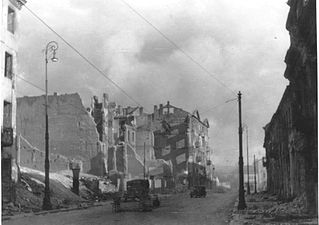Stroop Report

The Stroop Report is an official report prepared by General
History
The Report was commissioned by Friedrich-Wilhelm Krüger, chief of the SS and police in Kraków and was intended as a souvenir album for Heinrich Himmler. It was prepared in three distinct leather-bound copies for Himmler, Friedrich-Wilhelm Krüger and Jürgen Stroop. One unbound "file" copy of the report (das Konzept) remained in Warsaw, in the care of Chief of Staff Max Jesuiter.[1] According to a statement given in 1945 by Stroop's adjutant Karl Kaleshke to US authorities in Wiesbaden, he ordered Stroop's copy of the report burnt with other secret documents in Burg Kranzberg.[2]
After the war only two of the four copies were discovered, those belonging to Himmler and Jesuiter.[3] Himmler's copy went to Seventh Army Intelligence Center (SAIC) and Jesuiter's to Military Intelligence Research Section (MIRS) in London.[2] Several sources stated that the German Bundesarchiv also had a copy in Koblenz.[3][4][5] But, in reply to inquiries by Richard Raskin, the Bundesarchiv stated that the third copy of report was never in their possession.[1][2]
The two known copies held by the Allies were introduced as evidence at the
On June 10, 1948, the Himmler/SAIC copy of the Stroop report and Katzmann Report were handed over by Fred Niebergal, head of Office of Chief of Counsel for War Crimes – OCCWC, to Bernard Acht, head of the Polish Military Mission in Nuremberg.[2] It was used in Stroop's trial at Warsaw Criminal District Court in July 1951,[3] and transferred afterwards to the KC PZPR archive.[2] In 1952 it was transferred to the Główna Komisja Badania Zbrodni Hitlerowskich w Polsce (Main Commission for the Investigation of Nazi Crimes in Poland) archive and subsequently to its successor, the Institute of National Remembrance (Polish: Instytut Pamięci Narodowej or IPN), where it remains.[2] In 1948 the Jesuiter/MIRS copy of the report went to the National Archives (NARA) in Washington, D.C., where it continues to be held.[1]
In 2017, the Stroop Report was submitted by Poland and included in UNESCO's
Content

The Report was a 125-page typed document, bound in black pebble leather, with 53 photographs. It consisted of the following sections:
- Summary, with
- title page
- list of soldiers/Police killed and wounded
- the list of combat units involved, and
- Introduction, signed by Jürgen Stroop in the IPN copy
- Collection of 31 daily reports (German: Tägliche Meldungen), sent from Stroop's Chief of Staff Max Jesuiter to SS Police Leader East Friedrich-Wilhelm Krüger. The reports cover the period of 20 April to 16 May 1943, plus a report from 24 May 1943, and all were signed by Jesuiter.
- Series of 53 photographs accompanied by hand-written captions in German Sütterlin script
- The NARA report also has a fourth section with statistics about human losses, types of recovered weapons, and amounts of money and valuables taken from Jews.[2]
The copies have slight discrepancies in textual and graphical layout, and in the photographs they contain.
Photographs from the Stroop Report
The IPN copy of the report has 53 photographs on 49 pages, while the NARA copy has the same number of photographs on 52 pages. 37 photographs appear in both copies, although not always with the same size, crop or order and occasionally with different captions. Sixteen shots in each copy are different, although often very similar, as they depict the same events. Altogether, in both versions of the report, there are 69 unique photographs.[2][3]
The identity of the photographers who accompanied Stroop's headquarters during the operation is unknown. Franz Konrad confessed to taking some of the photographs; the rest were probably taken by photographers from Propaganda Kompanie nr 689.[2][3] In addition to the photographs found in the reports, there were about 45 additional photographs that were not included. According to Yad Vashem, these were found in Stroop's possession when he was captured by the Americans after the war.[9] Some of those photographs were closely related to those used in the report, as they depicted the same events. Many of those additional photographs are described in reputable sources as coming from the Stroop Report, even if they do not appear in either of the surviving copies.
The high-quality photographs taken for Stroop constitute a unique documentation of the final stage of liquidation of the Warsaw ghetto. The photographer was permitted access to Stroop's inner circle, to accompany the forces that participated in liquidating the ghetto, and to get close to the combat areas. Apart from a dozen candid photographs taken by Polish firefighter Leszek Grzywaczewski, those are the only photographs of the Ghetto Uprising taken inside the ghetto.[2] Some of them became highly recognized images of World War II and the Shoah.
Photographic captions in the Report are handwritten in the Sütterlin style. The captions contain few facts about the photos' content, and in some cases do not match the images at all. The captions often express the racist mindset of the report's authors. Many of the places, people and events depicted were not identified until after the report's publication.[citation needed]
Gallery
Photographs included in one of the two copies of the Stroop Report. Image captions include a reference and translation of the original German caption (in red), followed by current photo caption. Click on images for more information.
-
NARA copy #3, IPN copy #3Discussing the evacuation of the factoryThe guard on the left is Josef Blösche. The photo depicts the Herman Brauer helm repair shop at Nalewki 28–38. 24 April 1943
-
Time Magazine's most influential 100 photographs. Despite the three books written about the image, only the SS man pointing the submachine gun has been definitely identified, as Josef Blösche. Taken at Nowolipie 34.
-
NARA copy #43, IPN copy #43The leader of the grand operationSecond from left Stroop; background either Karl Kaleske (Stroop's adjutant) or Erich Steidtmann; 2nd from right Heinrich Klaustermeyer; far right Josef Blösche and others at Nowolipie 64 / Smocza 1 intersection
-
NARA copy #9, IPN copy #10Jewish RabbisRabbi Heschel Rappaport and others questioned by Heinrich Klaustermeyer and Josef Blösche in front of Nowolipie 32.
-
NARA copy #21, IPN copy #20Jewish traitorsStroop and Maximilian von Herff (likely) at Muranowski Square near Naleweki and Miła intersection with Nalewki 42 in the back. Possibly taken May 14, 1943
-
Majdanek; the other two died in the Shoah (Rachela Wyszogrodzka at left died in KZ Camp; her sister Bluma Wyszogrodzka was shot and killed after this picture was taken)
-
IPN copy #7Forcibly pulled out of bunkersCaptured Jews are led by Waffen SS soldiers to Umschlagplatz. In the back Nowolipie 62 & 63. See file page for possible identity of depicted people. The SS man at right has the "Totenkopf" Insignia on his collar.
-
NARA copy #7To the transhipping placeCaptured Jews are led by Waffen SS soldiers to Umschlagplatz. In the back Nowolipie 62 & 63. See file page for possible identity of depicted people.
-
NARA copy #6, IPN copy #6March to the rail stationColumn heading North to Umschlagplatz on Zamenhofa Street near Kupiecka. In the back buildings of Zamenhofa 30-40 block.
-
NARA copy #31To the transhipping placeColumn heading North to Umschlagplatz on Zamenhofa Street near Kupiecka. In the back buildings of Zamenhofa 30-40 block.
-
NARA copy #30, IPN copy #8To the transhipping placeColumn heading North to Umschlagplatz on Zamenhofa Street near Wołyńska. On the left 25, 27, 29.
-
NARA copy #44, IPN copy #44This is how the former Ghetto looks after having been destroyedColumn heading North to Umschlagplatz on Zamenhofa Street, with burning Zamenhofa 25 / Wołyńska 2 on the left.
-
NARA copy #29, IPN copy #28Transporting of Jews onwardColumn heading North to Umschlagplatz on Zamenhofa Street, with burning Zamenhofa 25 / Wołyńska 2 on the left.
-
MG08at the gate on Nowolipie Street intersection with Smocza Street, looking East. In the back Nowolipie 56.
-
Stroop Collection-not in the report-taken at Nowolipie 63[10]
-
Stroop Collection, not in the report.Cannon on Zamenhofa Street shooting North at resistance in Gęsia 20 building
-
Stroop Collection, not in the report.Zamenhofa Street looking North at resistance in Gęsia 20 building.
-
Stroop Collection, not in the report. 25 Niska Street 22 April 1943
See also
- Dachau Trials
- Nuremberg Trials
References
- ^ ISBN 978-8779340992.
- ^ a b c d e f g h i j Tomasz Stempowski (March 17, 2013). "Zdjęcia z powstania w getcie". fototekst.pl. Retrieved October 8, 2013.
- ^ ISBN 978-83-7629-455-1.
- ^ Yad Vashem Photo Archive
- ^ "United States Holocaust Memorial Museum".
- ^ International Military Tribunal "Blue Series," Vol. 2, p. 126
- ^ Conot, Justice at Nuremberg, 1983, pp. 269-70.
- ^ "Jürgen Stroop's Report". Memory of the World. United Nations Educational, Scientific and Cultural Organization. Retrieved 2018-10-09.
- ^ "The Stroop Collection". Yad Vashem. Retrieved 11 April 2016.
- ^ Warsaw forum (in Polish)
External links
 Media related to Stroop Report at Wikimedia Commons
Media related to Stroop Report at Wikimedia Commons- ISBN 9780394504438. (English translation)
- ISBN 978-83-7629-455-1. Retrieved April 11, 2016. (IPN copy; Polish translation: pages 23–112 and German original: pages 113–238; photographs)
- Jürgen Stroop. "The Jewish residential quarter in Warsaw has ceased to exist". www.holocaust-history.org. Archived from the original on March 8, 2010. (IPN copy; German original and English translation)
- Jürgen Stroop (May 1943). Es gibt keinen jüdischen Wohnbezirk in Warschau mehr!. File Unit: USA Exhibit 275, 1943 - 1946. Archived from the original on 2015-04-17. Retrieved 2017-09-15.
{{cite book}}:|website=ignored (help) (NARA copy; German original: text, photographs)

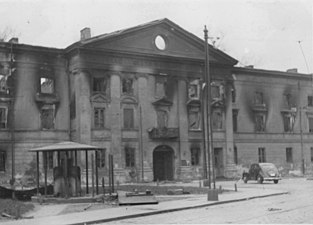








![NARA copy #43, IPN copy #43 The leader of the grand operation Second from left Stroop; background either Karl Kaleske [pl] (Stroop's adjutant) or Erich Steidtmann; 2nd from right Heinrich Klaustermeyer; far right Josef Blösche and others at Nowolipie 64 / Smocza 1 intersection](http://upload.wikimedia.org/wikipedia/commons/thumb/5/5e/Stroop_Report_-_Warsaw_Ghetto_Uprising_03.jpg/326px-Stroop_Report_-_Warsaw_Ghetto_Uprising_03.jpg)






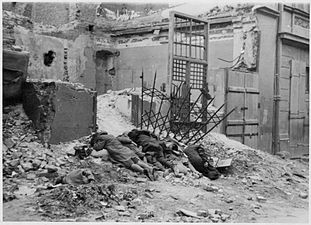








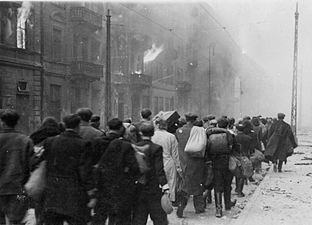









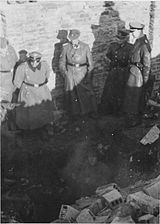











![Stroop Collection-not in the report-taken at Nowolipie 63[10]](http://upload.wikimedia.org/wikipedia/commons/thumb/3/35/Stroop_Report_-_Warsaw_Ghetto_Uprising_-_05507.jpg/344px-Stroop_Report_-_Warsaw_Ghetto_Uprising_-_05507.jpg)




















